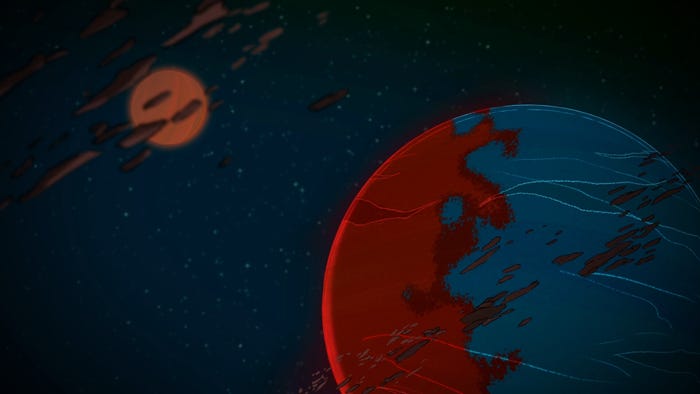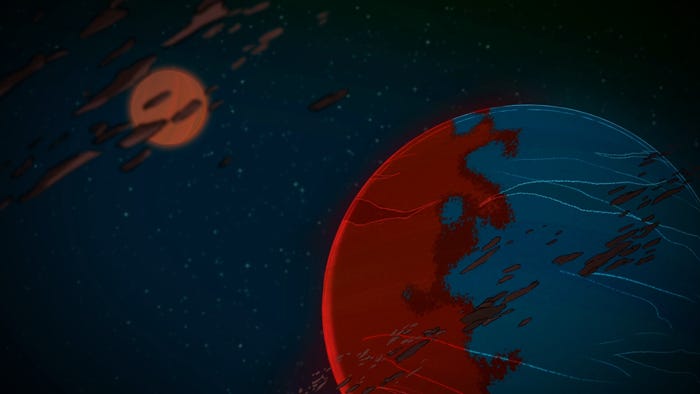
Game Developer Deep Dives are an ongoing series with the goal of shedding light on specific design, art, or technical features within a video game in order to show how seemingly simple, fundamental design decisions aren’t really that simple at all.
Earlier installments cover topics such as creating a game manual that accommodates multiple learning styles with director of The Banished Vault Nic Tringali, how Mimimi games crafted the save scum-friendly save system in Shadow Gambit: The Cursed Crew, and the technical work and creative nuances behind Slime Rancher 2‘s new weather system and the experiential impact that developers Monomi Park designed for players.
In this edition, Alvaro Martinez, game director of Lunar Lander Beyond and CTO of Dreams Uncorporated, explains how he and his team transformed an arcade-era title into a fully-fleshed out game universe.
Hey everybody! I’m Alvaro Martinez, game director of Lunar Lander Beyond and CTO of Dreams Uncorporated. We’re an indie game developer based in Colombia, mainly known for Cris Tales, although we’ve been making games for quite a while. In this article, I have the honor of telling you, dear readers, a little bit about the process of designing and directing Lunar Lander Beyond and how we reimagined a classic game and crafted a new experience around it.
We started by playing the original game and consciously analyzed every aspect to understand why it was designed the way it was. Of course, the technical limitations of the console it was released on played a huge part in shaping the original design, but still, many questions remained: Why are the controls the way they are? Who was the intended audience? Why is it so challenging?
And, inevitably, these questions lead to others: What is the game’s story? What is its setting? What is the mission of the lander? What was life like when it was released? What was part of the top on TV and in theaters?
With these questions in mind, we speculated and brainstormed. The controls and setting strongly suggested that Lunar Lander wanted to recreate, as accurately as possible, the challenges of landing on such an isolated place as the Moon. Examples of such challenges would include limited fuel capacity, which maybe translates into only one chance to land; the impossibility of refueling, which makes every drop of fuel precious; and the absence of atmosphere, implying any change of direction must be done using the thrusters, which spends fuel. If required to describe Lunar Lander in a few words, I’d choose Landing, Space, Challenge, Stress, Precision, Tight Controls, and Tension.
These keywords, or principles, are the ones we stuck with to preserve the classic game’s spirit. They are also a compass that helped me to set a vision for Lunar Lander Beyond and design the game with it in mind.
But to identify and keep the spirit of the original is just half of the journey. As much as we love the classic Lunar Lander, it was clear the new game needed an identity on its own. Based on our core principles, we needed to build new gameplay, new visuals, new music, new story, new lore. We needed to go from Lunar Lander to Lunar Lander Beyond.
It was another mental exercise that provided the answers we needed: the “what if” exercise. What if Lunar Lander was developed today instead of the ’70s? What would the designers do differently if they had today’s game development technology? What if it was developed for home consoles instead of arcade machines? Based on these, we imagined answers to these hypothetical questions and designed new features for Beyond.
Let’s think about possible answers to these questions for a moment. Game sessions would be longer since the player would have way more time to play the game than a game session in an arcade. Instead of rushing towards the landing pad, a player nowadays would like to explore the level to enjoy the visuals and the music. Without the pressure of monetizing the game by requiring coins for additional fuel, I believed the game would be more forgiving and casual. And without the technical limitations of the hardware back then, I thought the missions would be longer and the levels larger, featuring more planets/moons, each with unique gameplay features.

Images via Atari.
And that’s what we added to the game: beautiful graphics that are not just candy for the eyes but also a means to present a whole new fictional universe for the game to take place in; significant levels with plenty of areas to explore; music and atmosphere inspired by the ’80s movies I loved as a kid (as a nostalgia kicker for those who, like me, lived in the ’80s and enjoyed going to the arcades); more landers, each one with a unique control scheme, abilities and features; different planets each one with their own visuals and gameplay features and, the most important, a new factor to being taken into account gameplay-wise.
Let me talk about Pilots. The original game takes into account the physics of flying and landing, the fuel, landing on irregular terrain, etc., but an essential element it does not take into account is the pilots. The classic game gives us, the players, the role of the pilots. But what if we make pilots part of the game as well? What if we introduce the human factor into the simulation?
But what is the “human factor”? What differentiates us, as humans, from machines? A common trope in series and movies featuring any kind of AI is that machines do not have emotions. Machines are also not “capable of error,” nor do they have distinctive traits among the same models. Bingo! What if we add emotions and human characteristics to the core gameplay? What would happen if a pilot is so stressed they have a mental breakdown?
Asking ourselves these questions resulted in the addition of additional systems that complement the landing game mechanic: the Stress system, which can trigger the appearance of hallucinations during gameplay, and the Traits system, which modifies the flying simulation depending on the traits of the pilot that was chosen to carry on the mission. The introduction of hallucinations is the most prominent feature that differentiates, gameplay-wise, the original game from Lunar Lander Beyond.
Another concept that helped us create new elements around the core gameplay was gameplay customization. Take, for example, Hero-based games (i.e. MOBAs): where each Hero, aside from their own strengths and weaknesses, also has different talents or abilities to choose from. Depending on the build, the same hero can be tank-y or the epitome of a glass cannon; it’s up to the player to decide. Games like Overwatch take this one step further: each hero has their unique way of playing. Some require aim, precision timing, and hard mechanical skills, while others require more game sense and positioning.
In that regard, Lunar Lander Beyond features four different landers, each with their own feeling. Piloting each one of them should feel quite different from each other. Moreover, the players can equip up to three different abilities for each lander depending on what strategy or play style they want, customizing the experience even more in terms of gameplay. For instance, an ability allows the lander to teleport from one place to another, dramatically changing how levels are navigated.
So, we have different landers, each with their own physics and controls and lander abilities that can be equipped to expand lander capabilities. There is yet another layer of gameplay customization on top of that: enter Pilot Traits.
The Pilot Traits system is the way the game represents the different skill sets and personality traits each of us has that make us unique. Each pilot in the game starts with a random set of traits and learns another one each time they level up. These traits affect the performance of the lander in many different ways: for example, the Fast and Furious trait doubles top speed and acceleration.
Therefore, when the player chooses the pilot for a given mission, they need to consider what traits this particular pilot has. For example, in long missions, a pilot with the trait Fuel Saver would be a good choice, but in time-limited scenarios, Fast And Furious would be most appropriate. It all depends on what strategy the player wants to follow.
The combination of different landers, different ability setups and traits yields countless strategies to play the game. To some extent, the players customize the gameplay to fit their own strategy and play style.
Now, let me talk about the story. Despite its simplicity, the original game does have a story and setting: the landing of the Apollo missions on the moon. Because Beyond features missions on different solar system planets, it was clear that the game’s story needed to take place in the far future. It was also clear that since the game revolves around stress and tension, it would occur in a dystopian universe. Considering the time the original game was released and, as a way to bring nostalgic feelings to those players who were part of the audience back then, cyberpunk movies and novels were the proper inspiration for the Lunar Lander Beyond universe. TV series and movies such as Blade Runner, Automan, Alien, and 2001 Space Odyssey, among many others, greatly inspired me in this creative process.
Seeing the pilot light
The introduction of pilots shaped the story of the game in a significant way. The pilots are an integral part of the game, and their hallucinations greatly affect how the game world is perceived and played in. But why do the pilots see hallucinations from stress? Pilots are highly trained professionals, so they know how to stay calm in very stressful situations. So, why can’t Lunar Lander Beyond pilots remain calm despite their training? The answer to that question was the seed from which the game lore emerged.
In summary, we identified the message the classic game wanted to deliver, and while doing our best to keep it intact, we added new elements around it. The introduction of the pilots resulted in the addition of two additional systems that innovated the gameplay. Adding a rich lore, backed up by sprawling levels and rich visuals, helped us create a new experience for the players to immerse themselves in. A mix from old with new. Lunar Lander is the father, Lunar Lander Beyond is his proud son. At least, I hope it is.






